Potential of Cricket Chitosan for Nanoparticle Development Through Ionotropic Gelation: Novel Source for Cosmeceutical Delivery Systems
Abstract
:1. Introduction
2. Materials and Methods
2.1. Materials
2.1.1. Crickets
2.1.2. Chemicals
2.2. Experimental Methods
2.2.1. Defatted Cricket Powder and Chitosan Preparation
2.2.2. Characterizations of Cricket Chitosan
- Fourier-transform infrared (FT-IR) spectroscopy
- X-ray diffraction (XRD)
- Thermogravimetric analysis (TGA)
- Differential scanning calorimetry (DSC)
- Scanning electron microscopy (SEM)
- Proton nuclear magnetic resonance (1H-NMR) spectroscopy
2.2.3. Solubility Assessment
2.2.4. Determination of Water and Fat Binding Capacities
2.2.5. Determination of Molecular Weight
2.2.6. Determination of Irritation Potency and Cytotoxicity of Cricket Chitosan
- Hen’s Egg Chorio-Allantoic Membrane (HET-CAM) test
- 3-(4,5-Dimethylthiazol-2-yl)-2,5-diphenyl-2H-tetrazolium bromide (MTT) assay
- Crystal violet staining
2.2.7. Development of CNPs
- Optimization of CNP formulation
- Effect of crosslinking agent and CSC concentration
- 2.
- Effect of cricket chitosan concentrations
- Characterization of CNPs
- Stability test for CNPs from cricket chitosan
2.3. Statistical Analyses
3. Results and Discussions
3.1. Cricket Materials and Cricket Chitosan
3.2. Characterization of Cricket Chitosan
3.3. Solubility of Cricket Chitosan
3.4. Water and Fat Binding Capacities
3.5. Molecular Weight
3.6. Irritation Potency and Cytotoxicity of Cricket Chitosan
3.7. Development of CNPs
4. Conclusions
Author Contributions
Funding
Institutional Review Board Statement
Data Availability Statement
Acknowledgments
Conflicts of Interest
References
- Krongdang, S.; Phokasem, P.; Venkatachalam, K.; Charoenphun, N. Edible Insects in Thailand: An Overview of Status, Properties, Processing, and Utilization in the Food Industry. Foods 2023, 12, 2162. [Google Scholar] [CrossRef]
- Nischalke, S.; Wagler, I.; Tanga, C.; Allan, D.; Phankaew, C.; Ratompoarison, C.; Razafindrakotomamonjy, A.; Kusia, E. How to turn collectors of edible insects into mini-livestock farmers: Multidimensional sustainability challenges to a thriving industry. Glob. Food Secur. 2020, 26, 100376. [Google Scholar] [CrossRef]
- Rehman, K.U.; Hollah, C.; Wiesotzki, K.; Heinz, V.; Aganovic, K.; Rehman, R.U.; Petrusan, J.I.; Zheng, L.; Zhang, J.; Sohail, S.; et al. Insect-Derived Chitin and Chitosan: A Still Unexploited Resource for the Edible Insect Sector. Sustainability 2023, 15, 4864. [Google Scholar] [CrossRef]
- Edward; Wongprasert, T.; Bunyakanchana, T.; Siripitakpong, P.; Supabowornsathit, K.; Vilaivan, T.; Suppavorasatit, I. Cricket Protein Isolate Extraction: Effect of Ammonium Sulfate on Physicochemical and Functional Properties of Proteins. Foods 2023, 12, 4032. [Google Scholar] [CrossRef] [PubMed]
- He, X.; Li, K.; Xing, R.; Liu, S.; Hu, L.; Li, P. The production of fully deacetylated chitosan by compression method. Egypt. J. Aquat. Res. 2016, 42, 75–81. [Google Scholar] [CrossRef]
- Kulka, K.; Sionkowska, A. Chitosan Based Materials in Cosmetic Applications: A Review. Molecules 2023, 28, 1817. [Google Scholar] [CrossRef]
- Guzmán, E.; Ortega, F.; Rubio, R.G. Chitosan: A Promising Multifunctional Cosmetic Ingredient for Skin and Hair Care. Cosmetics 2022, 9, 99. [Google Scholar] [CrossRef]
- Sharma, A.; Agarwal, P.; Sebghatollahi, Z.; Mahato, N. Functional Nanostructured Materials in the Cosmetics Industry: A Review. Chem. Eng. 2023, 7, 66. [Google Scholar] [CrossRef]
- Gupta, V.; Mohapatra, S.; Mishra, H.; Farooq, U.; Kumar, K.; Ansari, M.J.; Aldawsari, M.F.; Alalaiwe, A.S.; Mirza, M.A.; Iqbal, Z. Nanotechnology in Cosmetics and Cosmeceuticals—A Review of Latest Advancements. Gels 2022, 8, 173. [Google Scholar] [CrossRef]
- Kaul, S.; Gulati, N.; Verma, D.; Mukherjee, S.; Nagaich, U. Role of Nanotechnology in Cosmeceuticals: A Review of Recent Advances. J. Pharm. 2018, 2018, 3420204. [Google Scholar] [CrossRef]
- Chuah, L.H.; Loo, H.L.; Goh, C.F.; Fu, J.Y.; Ng, S.F. Chitosan-Based Drug Delivery Systems for Skin Atopic Dermatitis: Recent Advancements and Patent Trends. Drug Deliv. Transl. Res. 2023, 13, 1436–1455. [Google Scholar] [CrossRef] [PubMed]
- Jha, R.; Mayanovic, R.A. A Review of the Preparation, Characterization, and Applications of Chitosan Nanoparticles in Nanomedicine. Nanomaterials 2023, 13, 1302. [Google Scholar] [CrossRef] [PubMed]
- Chaiyana, W.; Inthorn, J.; Somwongin, S.; Anantaworasakul, P.; Sopharadee, S.; Yanpanya, P.; Konaka, M.; Wongwilai, W.; Dhumtanom, P.; Juntrapirom, S.; et al. The Fatty Acid Compositions, Irritation Properties, and Potential Applications of Teleogryllus mitratus Oil in Nanoemulsion Development. Nanomaterials 2024, 14, 184. [Google Scholar] [CrossRef] [PubMed]
- Ganguly, K.; Dutta, S.D.; Jeong, M.S.; Patel, D.K.; Cho, S.J.; Lim, K.T. Naturally-Derived Protein Extract from Gryllus bimaculatus Improves Antioxidant Properties and Promotes Osteogenic Differentiation of hBMSCs. PLoS ONE 2021, 16, e0249291. [Google Scholar] [CrossRef]
- Amarender, R.V.; Bhargava, K.; Dossey, A.T.; Gamagedara, S. Lipid and Protein Extraction from Edible Insects—Crickets (Gryllidae). LWT—Food Sci. Technol. 2020, 125, 109222. [Google Scholar] [CrossRef]
- Ibitoye, E.B.; Lokman, I.H.; Hezmee, M.N.M.; Goh, Y.M.; Zuki, A.B.Z.; Jimoh, A.A. Extraction and Physicochemical Characterization of Chitin and Chitosan Isolated from House Cricket. Biomed. Mater. 2018, 13, 025009. [Google Scholar] [CrossRef]
- Acosta-Ferreira, S.; Castillo, O.S.; Madera-Santana, J.T.; Mendoza-García, D.A.; Núñez-Colín, C.A.; Grijalva-Verdugo, C.; Villa-Lerma, A.G.; Morales-Vargas, A.T.; Rodríguez-Núñez, J.R. Production and Physicochemical Characterization of Chitosan for the Harvesting of Wild Microalgae Consortia. Biotechnol. Rep. 2020, 28, e00554. [Google Scholar] [CrossRef]
- Rashid, T.U.; Rahman, M.M.; Kabir, S.; Shamsuddin, S.M.; Khan, M.A. A New Approach for The Preparation of Chitosan from Γ-Irradiation of Prawn Shell: Effects of Radiation on The Characteristics of Chitosan. Polym. Int. 2012, 61, 1302–1308. [Google Scholar] [CrossRef]
- Malm, M.; Liceaga, A.M. Physicochemical Properties of Chitosan from Two Commonly Reared Edible Cricket Species, and Its Application as a Hypolipidemic and Antimicrobial Agent. Polysaccharides 2021, 2, 339–353. [Google Scholar] [CrossRef]
- Chen, R.H.; Tsaih, M.L. Effect of Temperature on The Intrinsic Viscosity and Conformation of Chitosans in Dilute HCl Solution. Int. J. Biol. Macromol. 1998, 23, 135–141. [Google Scholar] [CrossRef]
- Muniandy, K.; Gothai, S.; Tan, W.S.; Kumar, S.S.; Mohd Esa, N.; Chandramohan, G.; Al-Numair, K.S.; Arulselvan, P. In Vitro Wound Healing Potential of Stem Extract of Alternanthera sessilis. Evid. Based Complement. Altern. Med. 2018, 2018, 3142073. [Google Scholar] [CrossRef] [PubMed]
- Chomchalao, P.; Saelim, N.; Lamlertthon, S.; Sisopa, P.; Tiyaboonchai, W. A Potential Thermosensitive Poloxamer 407-Based In Situ Hydrogel Containing Moxifloxacin-Loaded Silk Fibroin Nanoparticles for Prolonged Ocular Delivery. J. Drug Deliv. Sci. Technol. 2024, 99, 105988. [Google Scholar] [CrossRef]
- de Oliveira, J.L.; Campos, E.V.R.; Pereira, A.E.S.; Nunes, L.E.S.; da Silva, C.C.L.; Pasquoto, T.; Lima, R.; Smaniotto, G.; Polanczyk, R.A.; Fraceto, L.F. Geraniol Encapsulated in Chitosan/Gum Arabic Nanoparticles: A Promising System for Pest Management in Sustainable Agriculture. J. Agric. Food Chem. 2018, 66, 5325–5334. [Google Scholar] [CrossRef] [PubMed]
- Kim, E.S.; Kim, D.Y.; Lee, J.S.; Lee, H.G. Quercetin Delivery Characteristics of Chitosan Nanoparticles Prepared with Different Molecular Weight Polyanion Cross-Linkers. Carbohydr. Polym. 2021, 267, 118157. [Google Scholar] [CrossRef] [PubMed]
- Inoue, S.; Watanabe, T.; Hamaguchi, T.; Ishimaru, Y.; Miyawaki, K.; Nikawa, T.; Takahashi, A.; Noji, S.; Mito, T. Combinatorial Expression of Ebony and Tan Generates Body Color Variation from Nymph Through Adult Stages in The Cricket, Gryllus bimaculatus. PLoS ONE 2023, 18, e0285934. [Google Scholar] [CrossRef]
- Malm, M.; Liceaga, A.M.; San Martin-Gonzalez, F.; Jones, O.G.; Garcia-Bravo, J.M.; Kaplan, I. Development of Chitosan Films from Edible Crickets and Their Performance as a Bio-Based Food Packaging Material. Polysaccharides 2021, 2, 744–758. [Google Scholar] [CrossRef]
- Magara, H.J.O.; Niassy, S.; Ayieko, M.A.; Mukundamago, M.; Egonyu, J.P.; Tanga, C.M.; Kimathi, E.K.; Ongere, J.O.; Fiaboe, K.K.M.; Hugel, S.; et al. Edible Crickets (Orthoptera) Around the World: Distribution, Nutritional Value, and Other Benefits—A Review. Front. Nutr. 2021, 7, 537915. [Google Scholar] [CrossRef]
- Shah, A.A.; Wanapat, M. Gryllus testaceus walker (Crickets) Farming Management, Chemical Composition, Nutritive Profile, and Their Effect on Animal Digestibility. Entomol. Res. 2021, 51, 639–649. [Google Scholar] [CrossRef]
- Zainol Abidin, N.A.; Kormin, F.; Zainol Abidin, N.A.; Mohamed Anuar, N.A.F.; Abu Bakar, M.F. The Potential of Insects as Alternative Sources of Chitin: An Overview on the Chemical Method of Extraction from Various Sources. Int. J. Mol. Sci. 2020, 21, 4978. [Google Scholar] [CrossRef]
- Jampafuang, Y.; Tongta, A.; Waiprib, Y. Impact of Crystalline Structural Differences Between α- and β-Chitosan on Their Nanoparticle Formation Via Ionic Gelation and Superoxide Radical Scavenging Activities. Polymers 2019, 11, 2010. [Google Scholar] [CrossRef]
- Jaworska, M.; Sakurai, K.; Gaudon, P.; Guibal, E. Influence of Chitosan Characteristics on Polymer Properties. I: Crystallographic Properties. Polym. Int. 2003, 52, 198–205. [Google Scholar] [CrossRef]
- Podgorbunskikh, E.; Kuskov, T.; Rychkov, D.; Lomovskii, O.; Bychkov, A. Mechanical Amorphization of Chitosan with Different Molecular Weights. Polymers 2022, 14, 4438. [Google Scholar] [CrossRef] [PubMed]
- Psarianos, M.; Ojha, S.; Schneider, R.; Schlüter, O.K. Chitin Isolation and Chitosan Production from House Crickets (Acheta domesticus) by Environmentally Friendly Methods. Molecules 2022, 27, 5005. [Google Scholar] [CrossRef] [PubMed]
- Espinosa-Solís, A.; Velázquez-Segura, A.; Lara-Rodríguez, C.; Martínez, L.M.; Chuck-Hernández, C.; Rodríguez-Sifuentes, L. Optimizing Chitin Extraction and Chitosan Production from House Cricket Flour. Processes 2024, 12, 464. [Google Scholar] [CrossRef]
- Dong, Y.; Ruan, Y.; Wang, H.; Zhao, Y.; Bi, D. Studies on Glass Transition Temperature of Chitosan with Four Techniques. J. Appl. Polym. Sci. 2004, 93, 1553–1558. [Google Scholar] [CrossRef]
- Ogura, K.; Kanamoto, T.; Itoh, M.; Miyashiro, H.; Tanaka, K. Dynamic Mechanical Behavior of Chitin and Chitosan. Polym. Bull. 1980, 2, 301–304. [Google Scholar] [CrossRef]
- Kim, S.J.; Shin, S.R.; Kim, S.I. Thermal Characterizations of Chitosan and Polyacrylonitrile Semi-Interpenetrating Polymer Networks. High Perform. Polym. 2002, 14, 309–316. [Google Scholar] [CrossRef]
- Sakurai, K.; Maegawa, T.; Takahashi, T. Glass Transition Temperature of Chitosan and Miscibility of Chitosan/Poly (N-vinyl pyrrolidone) Blends. Polymer 2000, 41, 7051–7056. [Google Scholar] [CrossRef]
- Dresvyanina, E.N.; Dobrovol’Skaya, I.P.; Smirnov, V.E.; Popova, E.N.; Vlasova, E.N.; Yudin, V.E. Thermal Properties of Salt and Base Forms of Chitosan. Polym. Sci. Ser. A 2018, 60, 179–183. [Google Scholar] [CrossRef]
- Mei, L.; Fan, R.; Li, X.; Wang, Y.; Han, B.; Gu, Y.; Zhou, L.; Zheng, Y.; Tong, A.; Guo, G. Nanofibers for Improving the Wound Repair Process: The Combination of a Grafted Chitosan and an Antioxidant Agent. Polym. Chem. 2017, 8, 1664–1671. [Google Scholar] [CrossRef]
- Sánchez, L.F.; Cánepe, J.; Kim, S.; Nakamatsu, J. A Simple Approach to Produce Tailor-Made Chitosans with Specific Degrees of Acetylation and Molecular Weights. Polymers 2021, 13, 2415. [Google Scholar] [CrossRef] [PubMed]
- Ravi Kumar, M.N.V. A Review of Chitin and Chitosan Applications. React. Funct. Polym. 2000, 46, 1–27. [Google Scholar] [CrossRef]
- Oladipupo, S.O.; Wilson, A.E.; Hu, X.P.; Appel, A.G. Why Do Insects Close Their Spiracles? A Meta-Analytic Evaluation of the Adaptive Hypothesis of Discontinuous Gas Exchange in Insects. Insects 2022, 13, 117. [Google Scholar] [CrossRef] [PubMed]
- Wadhwa, S.; Paliwal, R.; Rai Paliwal, S.; Vyas, S.P. Chitosan and its Role in Ocular Therapeutics. Mini-Rev. Med. Chem. 2009, 9, 1639–1647. [Google Scholar] [CrossRef] [PubMed]
- Rodríguez-Núñez, J.R.; Madera-Santana, T.J.; Sánchez-Machado, D.I.; López-Cervantes, J.; Soto Valdez, H. Chitosan/Hydrophilic Plasticizer-Based Films: Preparation, Physicochemical and Antimicrobial Properties. J. Polym. Environ. 2013, 22, 41–51. [Google Scholar] [CrossRef]
- Sogias, I.A.; Khutoryanskiy, V.V.; Williams, A.C. Exploring the Factors Affecting the Solubility of Chitosan in Water. Macromol. Chem. Phys. 2010, 211, 426–433. [Google Scholar] [CrossRef]
- Panda, P.K.; Yang, J.M.; Chang, Y.H.; Su, W.W. Modification of Different Molecular Weights of Chitosan by P-Coumaric Acid: Preparation, Characterization and Effect of Molecular Weight on Its Water Solubility and Antioxidant Property. Macromol. 2019, 136, 661–667. [Google Scholar] [CrossRef]
- Chang, Y.C.; Chang, S.W.; Chen, D.H. Magnetic Chitosan Nanoparticles: Studies on Chitosan Binding and Adsorption of Co(II) ions. React. Funct. Polym. 2006, 66, 335–341. [Google Scholar] [CrossRef]
- Kim, M.W.; Song, Y.S.; Han, Y.S.; Jo, Y.H.; Choi, M.H.; Park, Y.K.; Kang, S.H.; Kim, S.A.; Choi, C.; Jung, W.J. Production of Chitin and Chitosan from The Exoskeleton of Adult Two-Spotted Field Crickets (Gryllus bimaculatus). Entomol. Res. 2017, 47, 279–285. [Google Scholar] [CrossRef]
- Wu, T.; Zivanovic, S.; Hayes, D.G.; Weiss, J. Efficient Reduction of Chitosan Molecular Weight by High-Intensity Ultrasound: Underlying Mechanism and Effect of Process Parameters. J. Agric. Food Chem. 2008, 56, 5112–5119. [Google Scholar] [CrossRef]
- Mohan, K.; Ganesan, A.R.; Ezhilarasi, P.N.; Kondamareddy, K.K.; Rajan, D.K.; Sathishkumar, P.; Rajarajeswaran, J.; Conterno, L. Green and Eco-Friendly Approaches for The Extraction of Chitin and Chitosan: A Review. Carbohydr. Polym. 2022, 287, 119349. [Google Scholar] [CrossRef] [PubMed]
- Howling, G.I.; Dettmar, P.W.; Goddard, P.A.; Hampson, F.C.; Dornish, M.; Wood, E.J. The Effect of Chitin and Chitosan on The Proliferation of Human Skin Fibroblasts and Keratinocytes In Vitro. Biomaterials 2001, 22, 2959–2966. [Google Scholar] [CrossRef]
- Izumi, R.; Komada, S.; Ochi, K.; Karasawa, L.; Osaki, T.; Murahata, Y.; Tsuka, T.; Imagawa, T.; Itoh, N.; Okamoto, Y.; et al. Favorable Effects of Superficially Deacetylated Chitin Nanofibrils on the Wound Healing Process. Carbohydr. Polym. 2015, 123, 461–467. [Google Scholar] [CrossRef] [PubMed]
- Triunfo, M.; Tafi, E.; Guarnieri, A.; Scieuzo, C.; Hahn, T.; Zibek, S.; Salvia, R.; Falabella, P. Insect Chitin-Based Nanomaterials for Innovative Cosmetics and Cosmeceuticals. Cosmetics 2021, 8, 40. [Google Scholar] [CrossRef]
- Chae, K.S.; Shin, C.S.; Shin, W.S. Characteristics of Cricket (Gryllus bimaculatus) Chitosan and Chitosan-Based Nanoparticles. Food Sci. Biotechnol. 2018, 27, 631–639. [Google Scholar] [CrossRef]
- Shu, X.Z.; Zhu, K.J.; Song, W. Novel pH-Sensitive Citrate Cross-Linked Chitosan Film for Drug Controlled Release. Int. J. Pharm. 2001, 212, 19–28. [Google Scholar] [CrossRef]
- Sacco, P.; Pedroso-Santana, S.; Kumar, Y.; Joly, N.; Martin, P.; Bocchetta, P. Ionotropic Gelation of Chitosan Flat Structures and Potential Applications. Molecules 2021, 26, 660. [Google Scholar] [CrossRef]
- Karpkird, T.; Manaprasertsak, A.; Penkitti, A.; Sinthuvanich, C.; Singchuwong, T.; Leepasert, T. A novel chitosan-citric acid crosslinked beta-cyclodextrin nanocarriers for insoluble drug delivery. Carbohydr. Res. 2020, 498, 108184. [Google Scholar] [CrossRef]
- Van Bavel, N.; Issler, T.; Pang, L.; Anikovskiy, M.; Prenner, E.J. A Simple Method for Synthesis of Chitosan Nanoparticles with Ionic Gelation and Homogenization. Molecules 2023, 28, 4328. [Google Scholar] [CrossRef]
- Masarudin, M.J.; Cutts, S.M.; Evison, B.J.; Phillips, D.R.; Pigram, P.J. Factors Determining The Stability, Size Distribution, and Cellular Accumulation of Small, Monodisperse Chitosan Nanoparticles as Candidate Vectors for Anticancer Drug Delivery: Application To The Passive Encapsulation of [14C]-Doxorubicin. Nanotechnol. Sci. Appl. 2015, 8, 67–80. [Google Scholar] [CrossRef]
- Vaezifar, S.; Razavi, S.; Golozar, M.A.; Karbasi, S.; Morshed, M.; Kamali, M. Effects of Some Parameters on Particle Size Distribution of Chitosan Nanoparticles Prepared by Ionic Gelation Method. J. Clust. Sci. 2013, 24, 891–903. [Google Scholar] [CrossRef]
- Jang, K.I.; Lee, H.G. Stability of Chitosan Nanoparticles for L-Ascorbic Acid During Heat Treatment in Aqueous Solution. J. Agric. Food Chem. 2008, 56, 1936–1941. [Google Scholar] [CrossRef] [PubMed]
- Morris, G.A.; Castile, J.; Smith, A.; Adams, G.G.; Harding, S.E. The Effect of Prolonged Storage at Different Temperatures on The Particle Size Distribution of Tripolyphosphate (TPP)—Chitosan Nanoparticles. Carbohydr. Polym. 2011, 84, 1430–1434. [Google Scholar] [CrossRef]
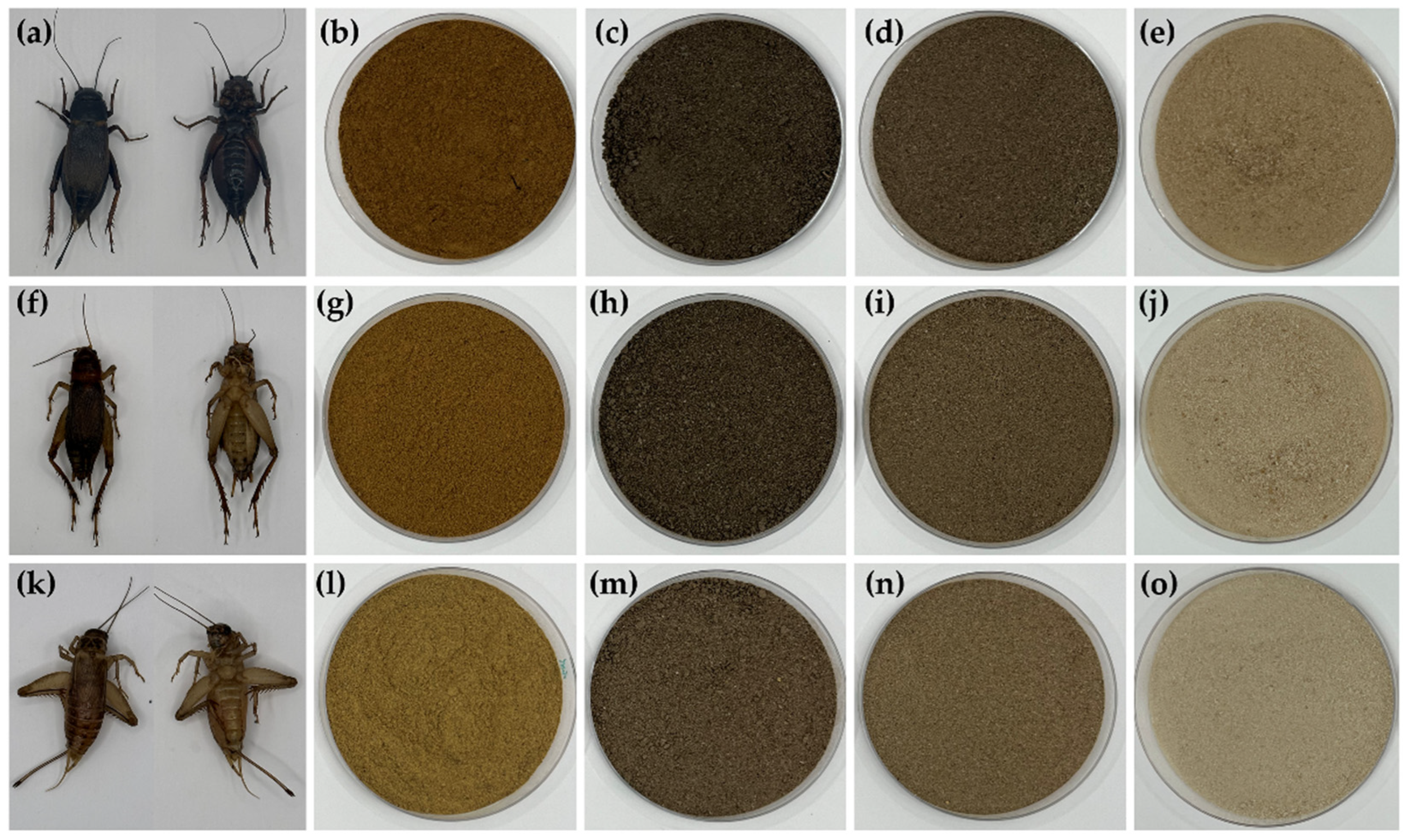
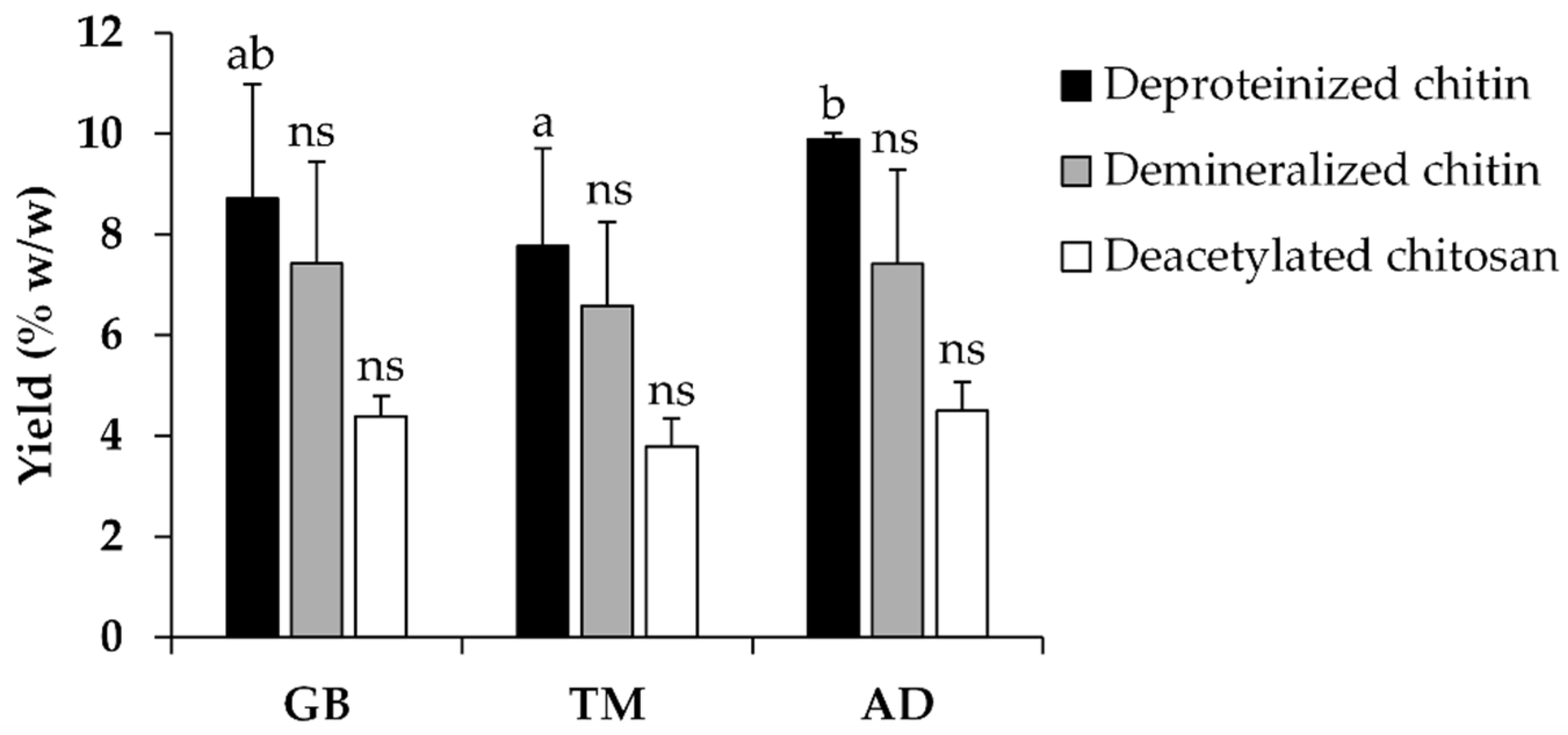


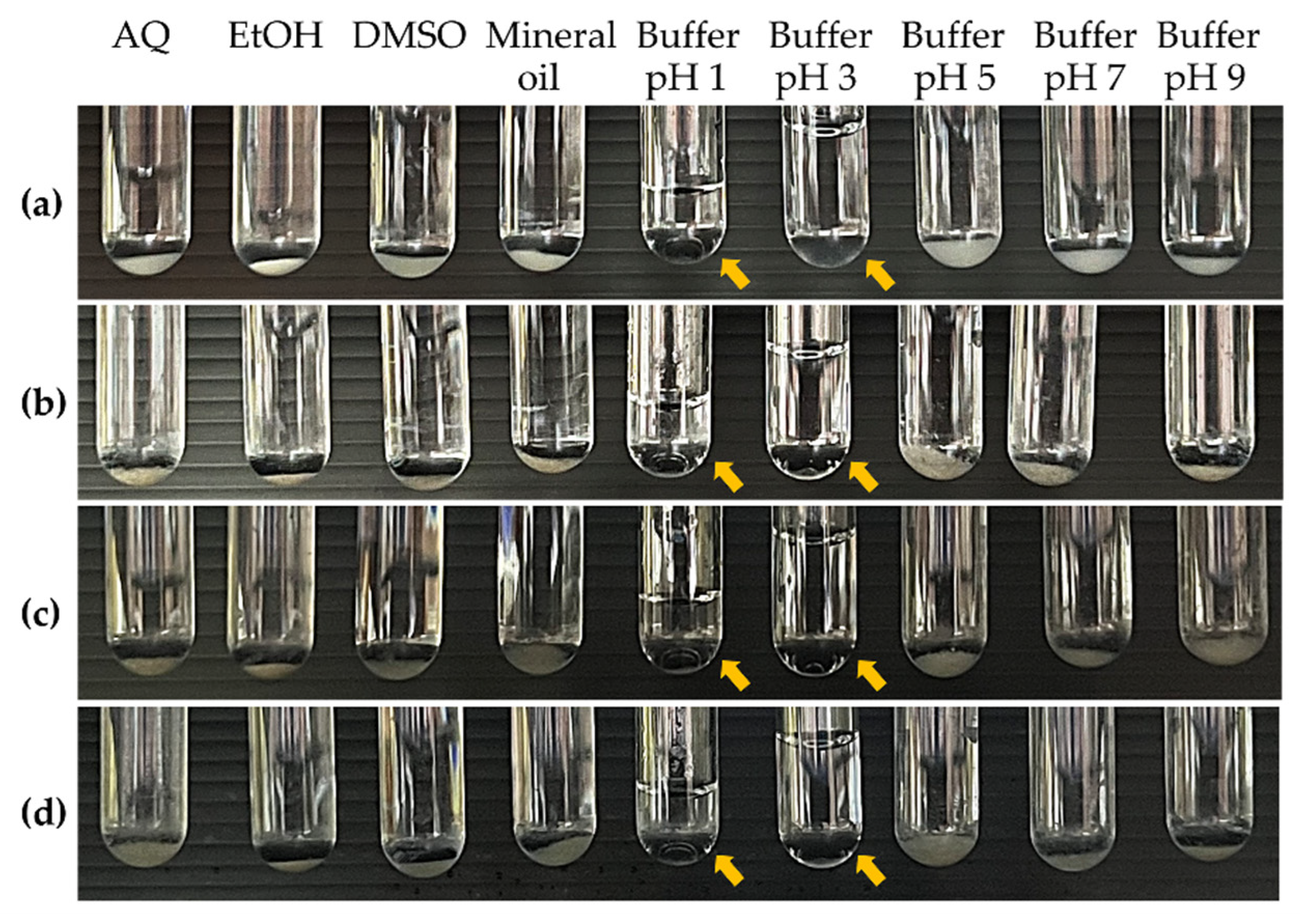
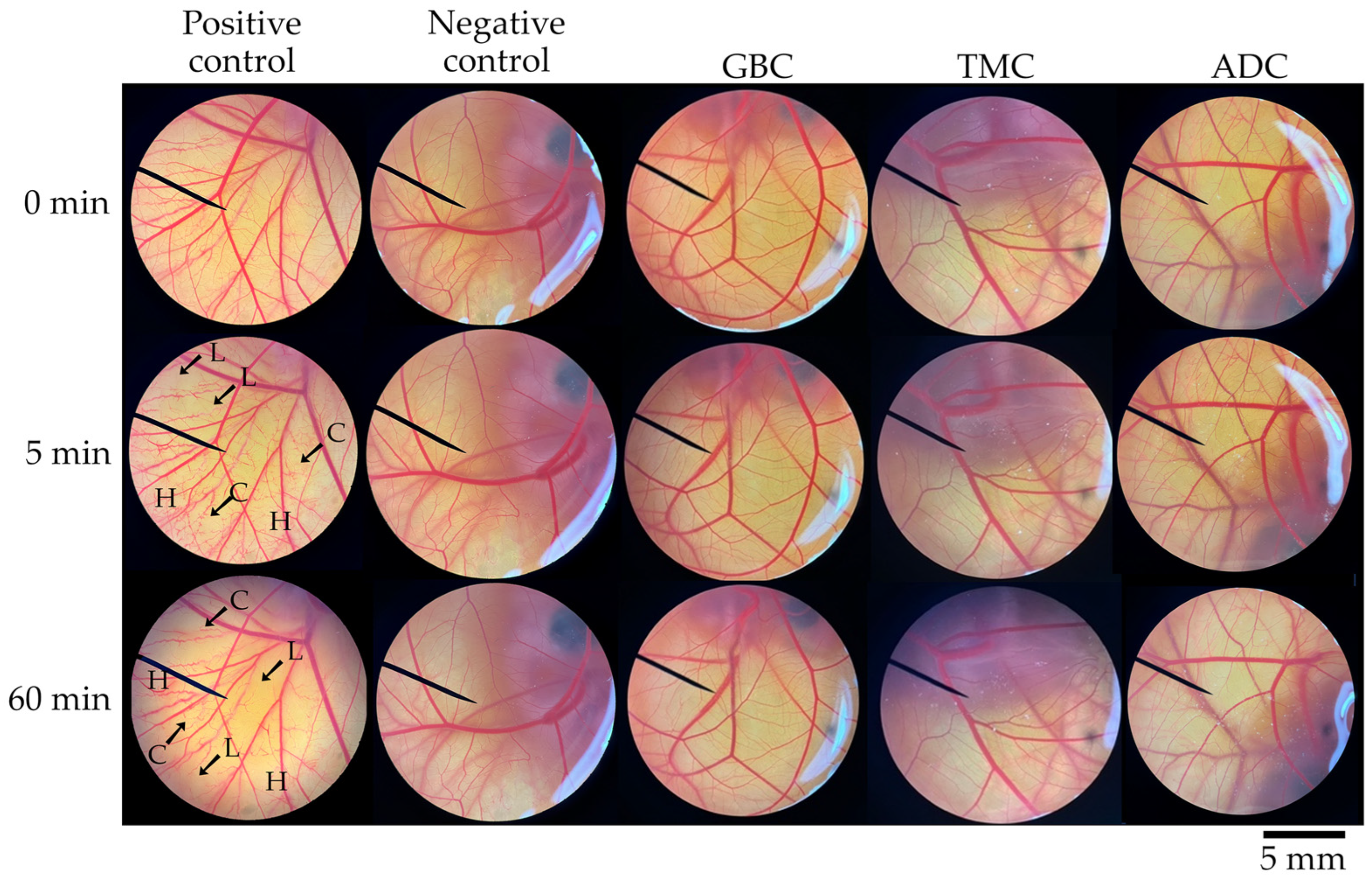
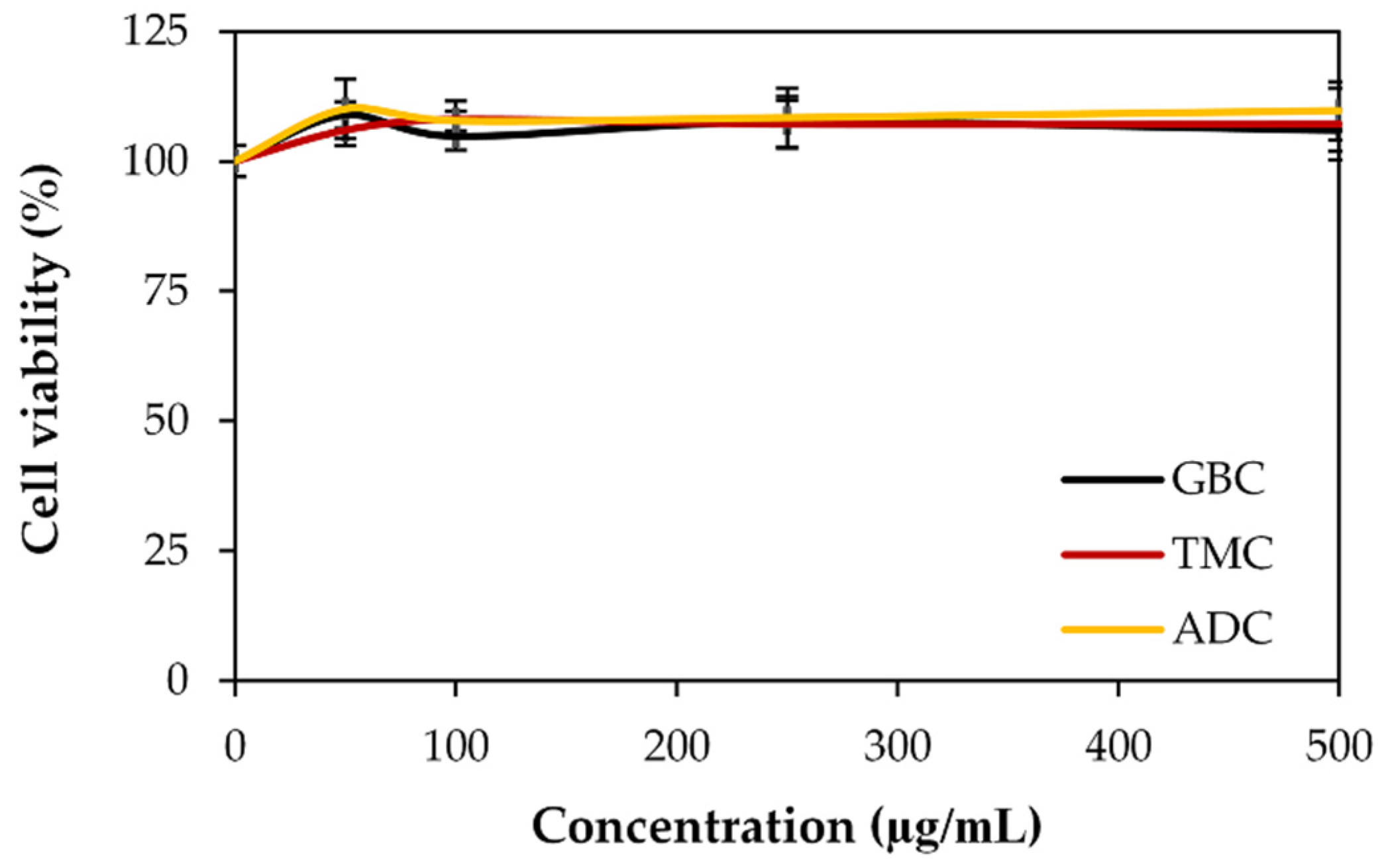
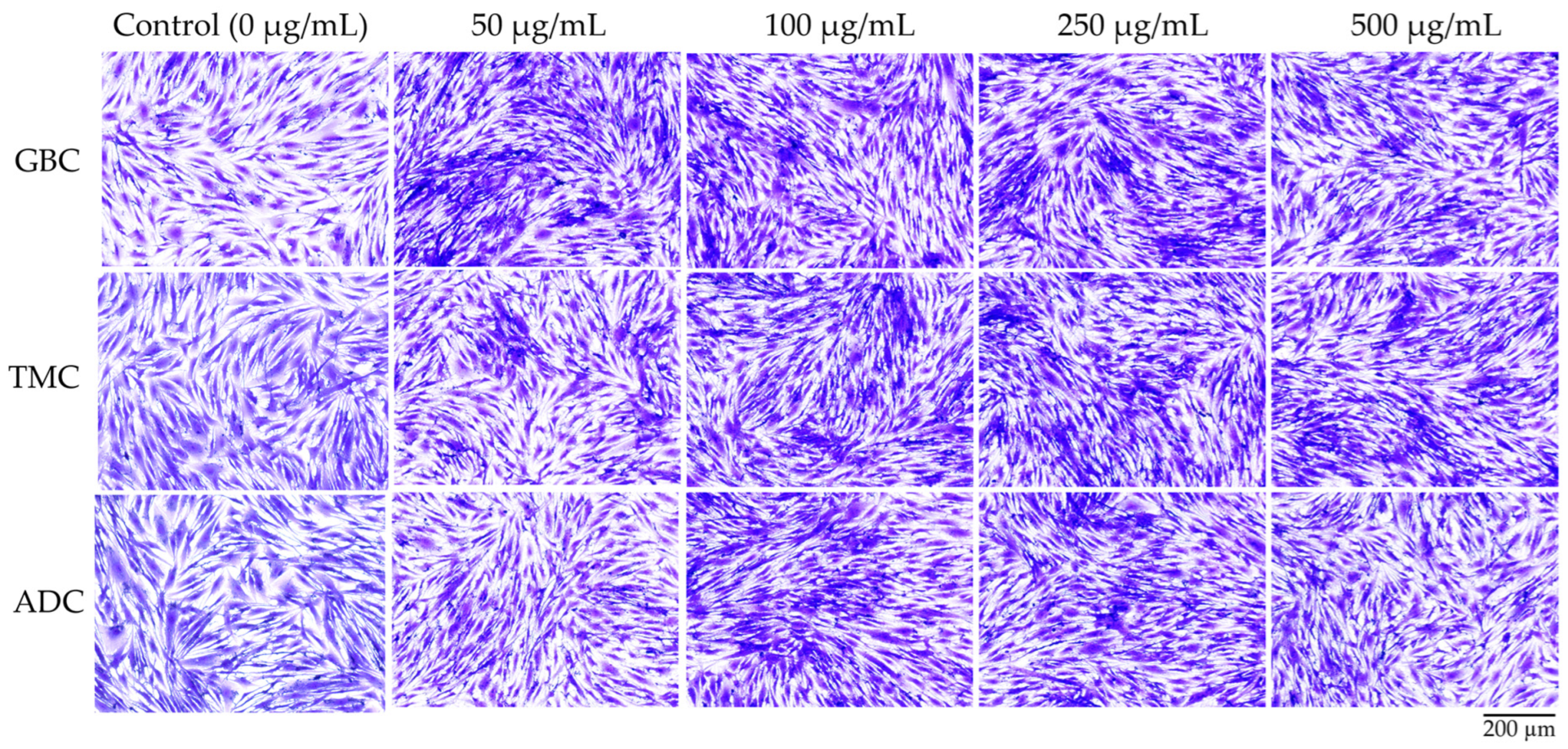


| Cricket Species | Production Yield (Mean ± SD) | ||
|---|---|---|---|
| Deproteinized Chitin | Demineralized Chitin | Deacetylated Chitosan | |
| G. bimaculatus | 8.71 ± 1.31 ab,B | 7.43 ± 1.17 ns,AB | 5.22 ± 0.99 ns,A |
| T. mitratus | 7.77 ± 1.12 a,B | 6.65 ± 0.97 ns,B | 4.35 ± 0.72 ns,A |
| A. domesticus | 9.91 ± 0.09 b,C | 7.50 ± 1.09 ns,B | 5.17 ± 0.89 ns,A |
| Samples | Solubility (mg/mL) | Molecular Weight (kDa) | Binding Capacity (%w/w) | ||
|---|---|---|---|---|---|
| Buffer pH 1 | Buffer pH 3 | Water Binding | Fat Binding | ||
| Commercial shrimp chitosan | 9.95 ± 0.67 a | 2.39 ± 0.12 a | 1428.50 ± 158.35 b | 620.67 ± 6.11 c | 550.67 ± 17.01 a |
| G. bimaculatus chitosan | 10.15 ± 0.47 a | 2.38 ± 0.13 a | 1000.47 ± 47.18 a | 596.00 ± 8.72 b | 528.00 ± 20.30 a |
| T. mitratus chitosan | 13.68 ± 1.32 b | 3.08 ± 0.23 b | 933.01 ± 9.37 a | 554.00 ± 11.14 a | 526.67 ± 5.03 a |
| A. domesticus chitosan | 14.51 ± 1.68 b | 3.77 ± 0.05 c | 919.35 ± 26.15 a | 756.00 ± 3.46 d | 694.67 ± 10.07 b |
| Samples | Irritation Score | Irritation Potency |
|---|---|---|
| Positive control | 19.2 ± 0.1 a | Severe irritation |
| Negative control | 0.0 ± 0.0 b | No irritation |
| G. bimaculatus chitosan | 0.0 ± 0.0 b | No irritation |
| T. mitratus chitosan | 0.0 ± 0.0 b | No irritation |
| A. domesticus chitosan | 0.0 ± 0.0 b | No irritation |
| Formulation | Commercial Shrimp Chitosan (CSC): Type and Amount of Crosslinking Agent (% w/w) | pH | Particle Size (nm) | Polydispersity Index (PDI) | Zeta Potential (mV) |
|---|---|---|---|---|---|
| F-01 | CSC 0.10:CA 0.075 | 3.34 | 581.4 ± 12.5 b,c | 0.89 ± 0.07 c | 32.7 ± 1.8 c |
| F-02 | CSC 0.10:CA 0.250 | 2.86 | 300.1 ± 19.8 a | 0.86 ± 0.09 c | 21.8 ± 2.1 b |
| F-03 | CSC 0.10:CA 0.750 | 2.48 | 243.3 ± 18.7 a | 0.91 ± 0.07 c | 13.5 ± 0.9 a,b |
| F-04 | CSC 0.10:GA 0.075 | 3.86 | 860.6 ± 55.7 d | 1.00 ± 0.00 c | 57.7 ± 1.1 d |
| F-05 | CSC 0.10:GA 0.250 | 3.86 | 661.0 ± 59.1 c | 1.00 ± 0.00 c | 55.1 ± 4.0 d |
| F-06 | CSC 0.10:GA 0.750 | 3.82 | 617.7 ± 24.4 c | 0.95 ± 0.06 c | 40.7 ± 6.1 c |
| F-07 | CSC 0.10:SC 0.075 | 4.52 | 256.4 ± 2.20 a | 0.28 ± 0.02 a | 21.4 ± 0.7 b |
| F-08 | CSC 0.10:SC 0.250 | 4.96 | 209.5 ± 0.7 a | 0.21 ± 0.00 a | 12.2 ± 1.2 a |
| F-13 | CSC 0.25:SC 0.250 | 5.00 | 494.2 ± 4.7 b | 0.58 ± 0.01 b | 16.6 ± 0.5 a,b |
| Formulation | Type and Amount of Chitosan: Sodium Citrate (% w/w) | Particle Size (nm) | Polydispersity Index (PDI) | Zeta Potential (mV) | |||
|---|---|---|---|---|---|---|---|
| Day 0 | Day 60 | Day 0 | Day 60 | Day 0 | Day 60 | ||
| F-16 | CSC 0.10:SC 0.25 | 216.0 ± 4.7 a | 255.5 ± 3.1 a,* | 0.185 ± 0.014 a | 0.248 ± 0.005 a,* | 9.7 ± 0.4 a | 16.6 ± 1.7 a,* |
| F-17 | CSC 0.15:SC 0.25 | 273.1 ± 3.2 b | 282.1 ± 6.7 b | 0.271 ± 0.004 b | 0.291 ± 0.010 a | 13.0 ± 1.3 b | 20.6 ± 1.5 b,* |
| F-18 | CSC 0.20:SC 0.25 | 380.3 ± 4.5 c | 379.4 ± 6.8 c | 0.481 ± 0.018 c | 0.369 ± 0.021 b,* | 13.7 ± 1.1 b | 21.8 ± 0.8 b,* |
| F-19 | CSC 0.25:SC 0.25 | 494.2 ± 4.7 d | 532.8 ± 0.6 d,* | 0.576 ± 0.009 d | 0.353 ± 0.026 b,* | 16.6 ±0.5 c | 27.9 ± 1.3 c,* |
| F-20 | GBC 0.10:SC 0.25 | 369.1 ± 3.2 a | 296.0 ± 5.7 a,* | 0.255 ± 0.009 a | 0.219 ± 0.017 a | 29.9 ± 3.5 a | 28.0 ± 1.6 a |
| F-21 | GBC 0.15:SC 0.25 | 547.1 ± 3.8 b | 463.0 ± 7.1 b,* | 0.477 ± 0.005 b | 0.402 ± 0.015 b,* | 30.0 ± 2.4 a | 30.8 ± 1.8 a |
| F-22 | GBC 0.20:SC 0.25 | 641.6 ± 18.1 c | 464.0 ± 4.5 b,* | 0.437 ± 0.043 b | 0.428 ± 0.001 b | 33.8 ± 3.6 a | 28.8 ± 3.1 a |
| F-23 | GBC 0.25:SC 0.25 | 666.4 ± 8.9 c | 479.2 ± 9.7 b,* | 0.455 ± 0.021 b | 0.410 ± 0.028 b | 34.7 ± 4.3 a | 29.2 ± 0.8 a |
| F-24 | TMC 0.10:SC 0.25 | 425.1 ± 2.8 a | 339.2 ± 3.0 a,* | 0.225 ± 0.017 a | 0.221 ± 0.008 a | 28.0 ± 1.6 a | 30.4 ± 1.3 a |
| F-25 | TMC 0.15:SC 0.25 | 509.0 ± 4.1 b | 404.1 ± 1.2 b,* | 0.458 ± 0.014 b | 0.273 ± 0.016 ab,* | 30.6 ± 1.8 a | 30.5 ± 1.0 a |
| F-26 | TMC 0.20:SC 0.25 | 635.5 ± 12.9 c | 426.2 ± 16.5 b,* | 0.411 ± 0.045 b | 0.314 ± 0.015 bc | 32.2 ± 2.7 a | 31.9 ± 2.5 a |
| F-27 | TMC 0.25:SC 0.25 | 686.0 ± 5.1 d | 552.6 ± 24.4 c,* | 0.482 ± 0.009 b | 0.348 ± 0.041 c | 32.3 ± 2.1 a | 36.8 ± 4.6 a |
| F-28 | ADC 0.10:SC 0.25 | 376.1 ± 3.0 a | 305.7 ± 3.4 a,* | 0.220 ± 0.021 a | 0.213 ± 0.026 a | 24.8 ± 2.0 a | 26.8 ± 1.9 a,* |
| F-29 | ADC 0.15:SC 0.25 | 398.4 ± 3.8 b | 378.2 ± 15.3 b | 0.382 ± 0.008 b | 0.305 ± 0.022 b,* | 25.3 ± 2.1 ab | 29.4 ± 3.4 a,* |
| F-30 | ADC 0.20:SC 0.25 | 426.7 ± 6.1 c | 382.5 ± 2.8 b,* | 0.340 ± 0.060 b | 0.333 ± 0.041 b | 30.2 ± 3.3 ab | 29.3 ± 1.0 a |
| F-31 | ADC 0.25:SC 0.25 | 522.0 ± 12.1 d | 392.8 ± 7.0 b,* | 0.388 ± 0.026 b | 0.368 ± 0.003 b | 34.2 ± 4.4 b | 30.3 ± 2.1 a |
Disclaimer/Publisher’s Note: The statements, opinions and data contained in all publications are solely those of the individual author(s) and contributor(s) and not of MDPI and/or the editor(s). MDPI and/or the editor(s) disclaim responsibility for any injury to people or property resulting from any ideas, methods, instructions or products referred to in the content. |
© 2024 by the authors. Licensee MDPI, Basel, Switzerland. This article is an open access article distributed under the terms and conditions of the Creative Commons Attribution (CC BY) license (https://creativecommons.org/licenses/by/4.0/).
Share and Cite
Inthorn, J.; Chomchalao, P.; Rithchumpon, P.; Juntrapirom, S.; Kanjanakawinkul, W.; Rades, T.; Chaiyana, W. Potential of Cricket Chitosan for Nanoparticle Development Through Ionotropic Gelation: Novel Source for Cosmeceutical Delivery Systems. Pharmaceutics 2024, 16, 1618. https://doi.org/10.3390/pharmaceutics16121618
Inthorn J, Chomchalao P, Rithchumpon P, Juntrapirom S, Kanjanakawinkul W, Rades T, Chaiyana W. Potential of Cricket Chitosan for Nanoparticle Development Through Ionotropic Gelation: Novel Source for Cosmeceutical Delivery Systems. Pharmaceutics. 2024; 16(12):1618. https://doi.org/10.3390/pharmaceutics16121618
Chicago/Turabian StyleInthorn, Jirasit, Pratthana Chomchalao, Puracheth Rithchumpon, Saranya Juntrapirom, Watchara Kanjanakawinkul, Thomas Rades, and Wantida Chaiyana. 2024. "Potential of Cricket Chitosan for Nanoparticle Development Through Ionotropic Gelation: Novel Source for Cosmeceutical Delivery Systems" Pharmaceutics 16, no. 12: 1618. https://doi.org/10.3390/pharmaceutics16121618
APA StyleInthorn, J., Chomchalao, P., Rithchumpon, P., Juntrapirom, S., Kanjanakawinkul, W., Rades, T., & Chaiyana, W. (2024). Potential of Cricket Chitosan for Nanoparticle Development Through Ionotropic Gelation: Novel Source for Cosmeceutical Delivery Systems. Pharmaceutics, 16(12), 1618. https://doi.org/10.3390/pharmaceutics16121618









